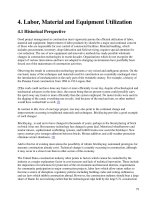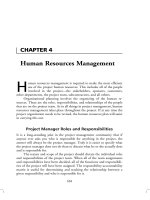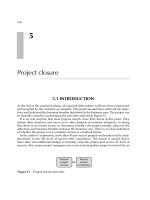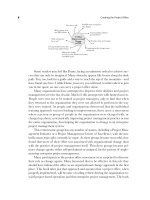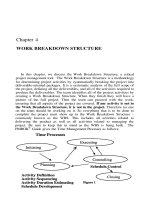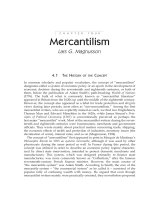Chapter 4 defining the project
Bạn đang xem bản rút gọn của tài liệu. Xem và tải ngay bản đầy đủ của tài liệu tại đây (2.99 MB, 29 trang )
Source: Mc Graw Hill Education. All Rights Reserved, 2021
CHAPTER 4:
DEFINING THE PROJECT
© 2021 McGraw-Hill Education. All rights reserved. Authorized only for instructor use in the classroom.
No reproduction or further distribution permitted without the prior written consent of McGraw-Hill Education.
4–2
Defining the Project
Step 1:
Defining the Project Scope
Step 2:
Establishing Project Priorities
Step 3:
Creating the Work Breakdown Structure
Step 4:
Integrating the WBS with the Organization
Step 5:
Coding the WBS for the Information System
4–3
Step 1: Defining the Project Scope
• Project Scope
– A definition of the end result or mission of the project—a
product or service for the client/customer — in specific,
tangible, and measurable terms.
• Purpose of the Scope Statement
– To clearly define the deliverable(s) for the end user.
– To focus the project on successful completion of its goals.
– To be used by the project owner and participants as a planning
tool and for measuring project success.
4–4
Project Scope Checklist
1. Project objective
2. Deliverables
3. Milestones
4. Technical requirements
5. Limits & exclusions
6. Reviews with customer
4–5
Project Scope: Terms & Definitions
• Scope Statements
– Also called statements of work (SOW)
• Project Charter
– Can contain an expanded version of scope statement
– A document authorizing the project manager to initiate & lead
the project.
• Project Creep
– The tendency for the project scope to expand over time due to
changing requirements, specifications, & priorities.
4–6
Step 2: Establishing Project Priorities
• Causes of Project Trade-offs
– Shifts in the relative importance of criterions related to cost,
time, and performance parameters
• Budget >< Cost
• Schedule >< Time
• Performance >< Scope
• Managing the Priorities of Project Trade-offs
– Constrain: a parameter is a fixed requirement.
– Enhance: optimizing a parameter over others.
– Accept: reducing (or not meeting) a parameter requirement.
4–7
Project Management Trade-offs
FIGURE 4.1
4–8
Project Priority Matrix
FIGURE 4.2
4–9
Step 3: Creating the Work
Breakdown Structure
• Work Breakdown Structure (WBS)
– An hierarchical outline (map) that identifies the products &
work elements involved in a project.
– Defines the relationship of the final deliverable (the
project) to its sub-deliverables, & in turn, their relationships
to work packages.
– Best suited for design & build projects that have tangible
outcomes rather than process-oriented projects.
4–10
Hierarchical
Breakdown of
the WBS
FIGURE 4.3
4–11
How WBS Helps the Project Manager
• WBS
– Facilitates evaluation of cost, time, and technical
performance of the organization on a project.
– Provides management with information appropriate to
each organizational level.
– Helps in the development of the organization breakdown
structure (OBS), which assigns project responsibilities to
organizational units and individuals
– Helps manage plan, schedule, and budget.
– Defines communication channels & assists in
coordinating the various project elements.
4–12
Work Breakdown Structure
FIGURE 4.4
4–13
Work Packages
• A work package is the lowest level of the WBS.
+ It is output-oriented in that it:
– Defines work (what).
– Identifies time to complete a work package (how long)
– Identifies a time-phased budget to complete a work package
(cost)
– Identifies resources needed to complete a work package (how
much)
– Identifies a single person responsible for units of work (who)
– Identifies monitoring points (milestones) for measuring success.
4–14
Step 4: Integrating the WBS
with the Organization
• Organizational Breakdown Structure (OBS)
– Depicts how the firm is organized to discharge its work
responsibility for a project.
• Provides a framework to summarize organization work unit
performance.
• Identifies organization units responsible for work packages.
• Ties the organizational units to cost control accounts.
4–15
Integration
of WBS
and OBS
FIGURE 4.5
4–16
Direct Labor Budget Sorted By WBS
TABLE 4.1A
4–17
Direct Labor Budget Sorted by OBS
TABLE 4.1B
4–18
Step 5: Coding the WBS
for the Information System
• WBS Coding System
– Defines:
• Levels & elements of the WBS
• Organization elements
• Work packages
• Budget and cost information
– Allows reports to be consolidated at any
level in the organization structure
4–19
WBS Coding
4–20
Work Package Estimates
FIGURE 4.6
4–21
Project Roll-up
• Cost Account
– The intersection of the WBS & the OBS that is a
budgetary control point for work packages.
– Used to provide a roll-up (summation) of costs
incurred over time by a work package across
organization units and levels, & by deliverables.
4–22
Direct Labor Budget
Rollup (000)
FIGURE 4.7
4–23
Process Breakdown Structure
• Process-Oriented Projects
– Are driven by performance requirements in which the
final outcome is the product of a series of steps of phases
in which one phase affects the next phase.
• Process Breakdown Structure (PBS)
– Defines deliverables as outputs required to move to the
next phase .
– Checklists for managing PBS:
• Deliverables needed to exit one phase & begin the next.
• Quality checkpoints for complete & accurate deliverables.
• Sign-offs by responsible stakeholders to monitor progress.
4–24
PBS for Software Project Development
FIGURE 4.8
4–25

